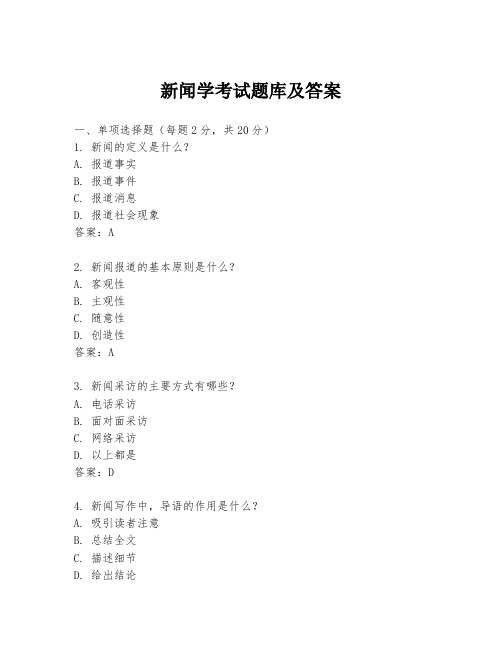12年12月新闻文体学作业及答案
新闻写作试题参考答案要点

一、解释下列概念:
1、消息:
2、通讯:
3、新闻由头:
4、新闻背景:
5、悬念式结构:
6、倒金字塔式结构:
7、并列式结构:
8、“故事化”:
二、你如何理解下面的说法,请举例说明:
1、新闻写作要追求个性化
2、新闻写作要追求“片面的深刻性”
3、新闻写作要“用事实说话”
4、新闻写作切忌“合理想象”
5、消息写作中,记者的观点不能直接表达,记者不发议论
6、新闻写作中的“空话”、“套话”要不得
7、消息的标题和导语中至少有一个兴奋点
8、新闻写作中的用语不当,会导致“媒介审判”
9、新闻写作中的“泛化”写法要不得
10、新闻娱乐化是新闻文化的发展方向
三、应用题:
1、这是一则采访笔记,请据此写一篇消息,要求字数在500字——600字之间。
答案要点:
2、下面文章是一篇通讯报道,请把它改写成500字——600字的一则消息。
答案要点:。
全国2012年10月自学考试新闻采访与写作试题及答案

全国2012年10月自学考试新闻采访写作试题一、单项选择题(本大题共25小题,每小题1分,共25分) 1.提出“新闻记者须有四能,即脑筋能想、腿脚能奔走、耳能听、手能写”的著名记者是A.邵飘萍B.徐宝璜C.范长江D.黄远生2.在采访中,记者要努力获取的具有很强的实证性、生动性和可读性的材料是A.骨干材料B.细节材料C.第一手材料D.第二手材料3.新闻采访的目的,简而言之就是A.了解社会情况B.识别和获得新闻C.锻炼新闻记者D.采集信息,传播信息4.我国一位党和国家领导人,谈到记者的使命时说,“你们的笔是人民的笔,你们是党和人民的耳目喉舌。
”这位领导人是A.毛泽东B.周恩来C.刘少奇D.邓小平5.在我国记者队伍中,最早以采写新闻通讯闻名,被誉为“新闻通讯文体的开拓者”的记者是A.邵飘萍B.黄远生C.梁启超D.戈公振7.新闻价值中的接近性,有地理上的接近、职业上的接近、年龄上的接近,更重要的是A思想上的接B情趣上的接近C.意识上的接近D.心理上的接近8.作为一种特殊的调查研究,新闻采访的难度主要表现在采访范围广泛,内容繁杂;记者与采访对象、受众之间多种关系;以及A.记者发出的报道生动形象B.采访既要讲效率,又要准确C.采访既要有速度,又要有深度D.记者要在尽可能短的时间内认识客观事物9.在我国新闻界,有位受人尊敬的前辈和青年记者谈到积累知识时说:“你们平时读报、读杂志,要准备一个小本本,有用的东西,要随手记下来。
’’这位前辈是A.穆青B.吴冷西C.邓拓D.安岗10.记者采访中了解新闻事实,最主要的渠道是A.开座谈会B.查阅资料C.访问D.记录11.采写目击式新闻,记者一般运用A.同步观察B.事前观察C.侧面观D.非闯入式观察12.记者采访提问,要求对方回答限定提问内容的提问方法是A.开放式提问B.闭合式提问C.迂回式提问D.诱导式提问13.采访时,记者在选题与报道内容选择的思考中采用上下结合的方法有利于A.反映民情民意B.找到采访要点C.宣传党的方针政策D.提高采访效率、提炼具有时代性的主题14.在采访方法中,最有利于了解各方面情况,有利于各方人士从不同角度、不同层次发表看法和意见的是A.个别访问B.召开座谈会C.集体采访D.新闻发布会15.记者在报道南水北调工程建设新进展时,了解到许多事实材料,对一些涉及施工、监理、保险、银行贷款等问题,记者听到一些不同说法,又去核实,这是A.找本人核实B.多方核实C.物证核实D.技术检验16.因事件访问与因人物访问的区别是A.能否随机应变B.是否有一定的准备C.是否注重现场D.以人物还是以事物为中心展开17.按照不同的写作形式和写作特点,我国新闻界通常把消息分为:动态消息、经验性消息、述评性消息,以及A.人物消息B.事件消息C.综合消息D.非事件性消息18.述评性消息的类型有形势述评、工作述评,以及A.科技述评B.环境述评C.思想述评D.文艺述评19.记者将采访中的所见、所闻、所感记录下来,加以公开报道的一种新闻式样,称为A.记者札记B.采访札记C.采访杂记D.记者杂感20.消息中背景材料的安排,大体有几种情形:安排在主体部分,或安排在消息的尾部,以及A.安排在抒情中B.安排在导语中C.安排在评述中D.安排在描写中21.报道新闻事实的一个方面,或就某些片断展开描述,以回答受众对某些方面关心或感兴趣的问题的通讯形式,称为A.速写B.侧记C.散记D.白描22.直接性导语除了叙述式导语、总结式导语,还有A.对比式导语B.引用式导语C.评述式导语D.描写式导语23.截取新闻事实的横断面,即抓住富有典型意义的某个空间和时间,通过一个片断、一个场面、一个镜头,对事件或人物、景物作出形象的报道,称为A.新闻素描B.新闻特写C.景物通讯D.社会特写24.消息结尾的写法,除了小结式结尾、号召式结尾、伏笔式结尾外,还有A.评论式结尾B.按时间顺序式结尾C.按逻辑顺序式结尾D.按空间变换式结尾25.通讯的纵式结构,一类具体表现方式是按时间顺序安排材料,另一类是A.按时空变化安排材料B.按空间变换安排材料C.依事物性质区别安排材料D.按作者认识发展顺序安排材料二、多项选择题(本大题共5小题,每小题2分,共10分)在每小题列出的五个备选项中至少有两个是符合题目要求的,请将其选出并将“答题纸”的相应代码涂黑。
新闻写作知识培训试题答案

新闻写作知识培训试题答案一、新闻写作概述新闻写作是传播新闻信息的重要手段,它要求作者在有限的篇幅内,准确、清晰、生动地传达新闻事件的实质。
新闻写作不同于其他文学创作,它更注重事实的真实性和时效性,以及信息的公共价值。
新闻写作的基本要求可以概括为“快、准、新、短、活”。
二、新闻要素与结构新闻报道需要包含五个基本要素,即“5W1H”:Who(谁)、What(什么)、When(何时)、Where(何地)、Why(为什么)和How(怎样)。
这些要素构成了新闻的骨架,确保读者能够迅速把握事件的核心信息。
新闻的结构通常遵循“倒金字塔”模式,即将最重要的信息放在文章的开头,然后按照信息重要性依次展开。
这种结构有助于读者快速获取关键信息,同时也方便编辑根据版面需要进行删减。
三、标题的撰写标题是新闻的眼睛,它需要在第一时间吸引读者的注意力,并准确反映新闻的主要内容。
一个好的标题应当简洁明了,避免使用夸张或模糊的词汇。
同时,标题应当具有一定的新闻价值,能够激发读者的阅读兴趣。
四、导语的撰写导语是新闻文章的开头部分,它用简洁的语言概述了新闻事件的核心内容,为读者提供了一个信息预览。
导语应当包含新闻的主要要素,并突出新闻的新颖性和重要性。
五、新闻正文的撰写新闻正文是详细阐述新闻事件的部分,它要求作者按照时间顺序或重要性顺序,全面、客观地描述事件。
在写作过程中,应当注意以下几点:1. 客观中立:新闻报道应当保持客观公正,避免带有个人情感色彩的描述。
2. 事实核实:确保报道中的每一个事实都有可靠的来源和证据支持。
3. 语言精炼:使用简洁明了的语言,避免冗长复杂的句子结构。
4. 引用权威:在报道中引用专家意见或权威数据,增加新闻的可信度。
六、新闻结尾的撰写新闻的结尾部分应当对全文进行总结,强调新闻事件的意义和影响。
在一些情况下,结尾也可以提出问题或展望未来,引发读者的思考。
七、新闻写作的伦理道德新闻写作不仅要追求报道的真实性和时效性,还要遵循伦理道德原则。
新闻考试题及答案小学

新闻考试题及答案小学一、选择题(每题2分,共20分)1. 新闻报道的五要素包括:时间、地点、人物、事件和____。
A. 原因B. 结果C. 过程D. 影响2. 下列哪一项不是新闻的特点?A. 真实性B. 时效性C. 娱乐性D. 客观性3. 新闻报道中,以下哪个词组表示的是“新闻来源”?A. 新闻线索B. 新闻背景C. 新闻主体D. 新闻出处4. 新闻标题的编写应遵循以下哪个原则?A. 简洁明了B. 复杂难懂C. 随意编造D. 长篇大论5. 新闻报道中,记者应该保持的态度是:A. 客观公正B. 主观臆断C. 情绪化D. 随意性6. 新闻报道的类型不包括:A. 消息B. 通讯C. 评论D. 广告7. 新闻报道中,以下哪个不是常见的报道方式?A. 现场报道B. 深度报道C. 访谈报道D. 虚构报道8. 新闻采访的基本步骤包括:确定主题、采访准备、实地采访和____。
A. 新闻发布B. 资料整理C. 撰写稿件D. 编辑校对9. 新闻报道中,以下哪个词组表示的是“新闻价值”?A. 新闻敏感B. 新闻时效B. 新闻重要性D. 新闻趣味性10. 新闻报道中,以下哪个词组表示的是“新闻角度”?A. 新闻视角B. 新闻立场C. 新闻深度D. 新闻广度二、填空题(每空1分,共10分)11. 新闻报道的首要原则是____。
12. 新闻报道的三个基本要求是真实性、时效性和____。
13. 新闻标题应具有____、____和____。
14. 新闻采访的目的是获取第一手资料,为撰写新闻稿件提供依据。
15. 新闻报道的类型包括消息、通讯、评论等,其中消息是最常见的报道形式,它以____、____和____为主。
三、简答题(每题10分,共20分)16. 简述新闻报道的三个基本特点。
17. 简述新闻采访的一般过程。
四、论述题(共30分)18. 论述新闻报道在社会生活中的作用和意义。
五、案例分析题(共20分)19. 阅读以下新闻报道案例,分析报道的新闻价值和报道方式。
(完整版)新闻采访与写作试题与答案A,推荐文档

科技新闻报道(A卷)一、单项选择题(每小题1分,共10分)1、我国的新闻采访学研究萌芽于()A 古代报刊时期B近代报刊时期 C 现在报刊时期 D 当代报刊时期2、我国历史上第一本新闻采访学专著《实际应用新闻学》作者是()A 徐宝璜B范长江 C 邹韬奋 D 邵飘萍3、毛泽东称记者是()A 记的人B无冕之王C社会活动家 D 宣传家4、被蔡元培誉为“在我国新闻界实为破天荒之作”的是()A 《时报发刊例》B《论日报渐行于中土》C《实际应用新闻学》D《新闻学》5、在我国,选择新闻的主要标准是()A 真实性与时效性B受众第一C社会效益与经济效益 D 新闻价值与新闻政策6、作为新闻团体制定的职业准则,始于()A 1908年美国密苏里大学新闻学院院长威廉博士提出的《记者信条》B 1914年瑞士新闻业总会通过的新闻道德规范C 1923年美国报纸编辑人协会通过的《美国报业信条》D 1977年由阿拉伯新闻人员起草的一项阿拉伯新闻工作职业道德准则7、关于新闻策划,下列说法不正确的是()A 新闻策划就是指报道策划B 新闻策划不是策划新闻C 新闻报道策划不能与制造新闻混为一谈D 新闻报道策划是指在承认新闻是客观事物的反应这一前提下的策划8、能鲜明的体现出我国新闻工作者的职业道德观的是()A 坚持哪个正确舆论导向B全心全意为人民服务C发扬团队合作精神 D 维护新闻的真实性9、关于坚持新闻的真实性原则,下列说法不正确的是()A 是党性在新闻问题上的一个具体表现B就伦理学的意义说,就是实事求是,讲真话C就要反对弄虚作假,反对“客里空”作风D就是要客观主义报道10、记者在调查研究时,总是着眼于新,抓住那些具有新闻价值的新信息、新事实。
这说明记者的调查研究具有()A 新闻性B 时效性C 政策性D 广泛性二、填空题(每小题2分,共20分)11、新华社第一个国外分社于1948年建立在12、在《敬告我同业诸君》一文中,认为“报馆有两大天职:一曰对于政府而为其监督者,二曰对于国民而为起响导者是也”。
新闻学考试题库及答案

新闻学考试题库及答案一、单项选择题(每题2分,共20分)1. 新闻的定义是什么?A. 报道事实B. 报道事件C. 报道消息D. 报道社会现象答案:A2. 新闻报道的基本原则是什么?A. 客观性B. 主观性C. 随意性D. 创造性答案:A3. 新闻采访的主要方式有哪些?A. 电话采访B. 面对面采访C. 网络采访D. 以上都是答案:D4. 新闻写作中,导语的作用是什么?A. 吸引读者注意B. 总结全文C. 描述细节D. 给出结论答案:A5. 新闻摄影的主要目的是什么?A. 美化新闻B. 增加新闻的趣味性C. 为新闻提供视觉证据D. 娱乐大众答案:C6. 新闻评论的主要功能是什么?A. 娱乐大众B. 提供信息C. 引导舆论D. 教育公众答案:C7. 新闻编辑的主要任务是什么?A. 选择新闻B. 编辑新闻C. 校对新闻D. 以上都是答案:D8. 新闻传播的主要渠道有哪些?A. 报纸B. 电视C. 互联网D. 以上都是答案:D9. 新闻自由的含义是什么?A. 新闻工作者可以随意报道B. 新闻工作者可以不受任何限制C. 新闻工作者在法律允许的范围内自由报道D. 新闻工作者可以无视法律答案:C10. 新闻伦理的主要内容包括哪些?A. 真实性B. 客观性C. 公正性D. 以上都是答案:D二、多项选择题(每题3分,共15分)1. 新闻报道中常见的写作手法包括哪些?A. 倒金字塔结构B. 时间顺序结构C. 并列结构D. 问题-答案结构答案:ABCD2. 新闻摄影中需要注意的要素有哪些?A. 光线B. 构图C. 色彩D. 主题答案:ABCD3. 新闻评论中常见的论证方法包括哪些?A. 举例论证B. 比较论证C. 因果论证D. 类比论证答案:ABCD4. 新闻编辑在处理新闻稿件时需要考虑的因素有哪些?A. 新闻价值B. 时效性C. 准确性D. 可读性答案:ABCD5. 新闻传播中需要遵守的法律法规包括哪些?A. 著作权法B. 隐私权法C. 诽谤法D. 信息安全法答案:ABCD三、简答题(每题10分,共20分)1. 简述新闻报道的五个W原则。
高考“新闻类阅读”题型归纳及练习(附答案解析)

高考“新闻类阅读”题型归纳及练习(附答案解析)▲新闻类文本阅读考点分解如下1、理解语句含义题2、筛选整合信息题3、概括分析人物形象题4、导语的作用题5、背景的作用题6、结语的作用题7、文本结构安排题(顺序、倒叙、补叙、日记体)8、鉴赏新闻的表现手法9、分析语言特色题10、分析新闻的文体特征题11、探究新闻的写作背景和写作意图12、探究新闻反映的人生价值和时代精神(文本封闭性和半开放型)语句含义题:结合上下文,抓关键词。
表层涵义+深层涵义例1.《温暖人心的冬奥:索契有的不仅是冰冷的赛道》理解文中两处画线句子的含义。
答:通过“愣”“抱在一起痛哭”的神态和动作描写,写出了兰妮听到姐姐的决定后的震惊和感动,姐姐为妹妹有机会实现梦想的激动和欣慰,(表层义)体现出她们姐妹情深,展现了奥林匹克精神中的无私奉献品质。
(深层义)筛选信息题:【方法小结】①阅读全文,了解新闻报道了什么地点、什么时间、什么人物、发生了什么事,其发展如何、结局如何。
②看清题目,明确筛选要求,寻找答题的有效信息区间。
③在有效信息区间,抓住关键词句,把握新闻要点,进行筛选整合。
④根据题目,结合筛选的词句分条作答。
新闻导语题:①概述新闻的主要内容和事实,鲜明地揭示新闻的中心。
②抓典型镜头,给读者以现场感和生动感;吸引读者的阅读兴趣。
③为全篇奠定恰当(紧张或温馨或欢快或沉郁或悲痛)的感情基调,贯穿全文。
④结构上引出下文对某事件的具体描写。
⑤手法:用列数字、举例子、作比较等手法表现新闻事件的特点。
新闻背景题:例1.文章前两个场景用较多的文字再现了冬奥会赛场外的场景,作者为什么这样写?答:①对新闻事实进行解释、补充烘托,加深对新闻的认识和理解:哥哥脑瘫,陪伴参赛;兰妮无缘冬运会的原因,使文章内容更加全面。
(可以让读者全方位了解事情的真相)(或与新闻事实形成对比)②突出人物特征,体现出兄弟之义、姐妹之情的深厚程度。
(深刻理解他们获奖之后激动的心情,突出他们的兄弟之义、姐妹之情)③揭示了新闻事件的意义,体现新闻的主题,增强了新闻的厚度和深度,歌颂了冬奥赛场上人间的温情。
2012-2013新闻写作试卷B

安徽大学2012 —2013学年第2学期《 新闻写作》考试试卷(B 卷)(开卷 时间120分钟)考场登记表序号一、分析题(共50分)下面是一篇消息,请分析回答以下问题: 1.这是一篇什么类型的消息?请简要说明理由。
(8分) 2.这篇消息采用了什么结构形式?请简要说明判断依据。
(10分) 3.这篇消息的导语属于什么类型,具有什么特点?(8分) 4.指出这篇消息的背景材料,并说明它们的类型及作用。
(12分) 5.分析这篇消息的写作特点(12分)中国“城管”亟待提高执法水平【美国《华盛顿邮报》网站2013年4月1日报道】题:中国民众对城管为难小商小贩表示越来越大的不满(记者 威廉〃万)在中国,骚扰、有时候甚至殴打和勒索街头商贩的政府雇员成了最被民众鄙视的人之一。
他们的官方名称叫“城管”,即城市管理人员。
但这个词已经引申为滥用暴力来解决问题者。
最近几个星期,一些城管为难小商小贩的事件在国内微博上广为流传,激起了大量网友评论,也让民众对城管的不满达到一个新高点。
在上周网上公布的一个视频中,目击者说城管执法人员殴打盲人。
几名城管被指将一名盲人乞讨者打伤丢入水中,并没收其导盲棍、行乞碗和里面的零钱。
在另一起城管执法事件中,网上公布的照片显示一群城管殴打一名卖水果的小贩并把她抓起来,背景中女摊贩幼小的女儿在无助地哭泣。
正因为这些事件,城管执法人员从很多方面来说成了政府威权统治的一个缩影——特别是对几十亿处于社会底层的农民工来说,他们正越来越多地用抗议和暴力来表达自己的愤怒和失望。
几乎所有的群体性事件都和官员滥用职权、激起农民工和其他人的不满有关。
虽然政府已经意识到底层民众的这种不满,并在演讲、政策和新官员培训中承认了这一点,但它似乎不愿放弃对城管的使用,认为城管是其庞大的安全体系的基层堡垒。
中国的城管部门是1997年开始设立的,作为一个负责管理停车、环境卫生等非刑事的城市行政问题的执法机关。
从那以后,在中国领导人把维稳作为首要任务的背景下,随着国内安全人员数量的不断增长,城管的数量也急剧增加。
- 1、下载文档前请自行甄别文档内容的完整性,平台不提供额外的编辑、内容补充、找答案等附加服务。
- 2、"仅部分预览"的文档,不可在线预览部分如存在完整性等问题,可反馈申请退款(可完整预览的文档不适用该条件!)。
- 3、如文档侵犯您的权益,请联系客服反馈,我们会尽快为您处理(人工客服工作时间:9:00-18:30)。
12年12月新闻文体学作业
及答案
-标准化文件发布号:(9456-EUATWK-MWUB-WUNN-INNUL-DDQTY-KII
《新闻文体学》作业
本课程作业由两部分组成。
第一部分为“客观题部分”,由15个选择题组成,每题1分,共15分。
第二部分为“主观题部分”,由简答题和论述题组成,共15分。
作业总分30分,将作为平时成绩记入课程总成绩。
客观题部分:
一、选择题(每题1
分,共15题)
1. 选择下面说法正确的()
A、狭义的新闻,是指未在报刊上发表的新闻。
B、狭义的新闻,是指不包括新闻评论的新闻报道。
C、狭义的新闻,即等于消息这一文体。
2. 选择下面说法正确的()
A、简讯,是不大重要的简单的新闻消息。
B、简讯,是与消息、通讯等同的新闻报道的典型体裁。
C、简讯不是新闻报道的典型体裁。
3. 选择下面说法正确的()
A、运用某些属性相同的例子,推论出其他事物也可能有相同的属性的论证方法,叫例证法。
B、运用某些属性不同的例子,推论出其他事物也可能有相同的属性的论证方法,叫对比法。
C、运用某些属性相同的例子,推论出其他事物也可能有相同的属性的论证方法,叫类比法。
4.以下正确的是()
A、新闻标题是在一篇文章前,将新闻的内容或主题加以概括以后单独出的简短文字。
B、新闻标题是在一篇或一组新闻本文前面,将新闻的内容或主题加以概括以后单独标出的简短文字。
C、新闻标题是在一篇或一组新闻的较前面,将新闻的内容加以概括以后单独标出的简短文字。
5.以下正确的是()
A、新闻,是广大群众欲知、应知而未知的事实。
B、新闻,是新近发生的事实的报道。
C、新闻,是报道或评述最新的重要事实以影响舆论的特殊行为。
6.以下正确的是 ( )
A、“日本朋友×××见义勇为烟台挽救落水儿童”,是目的关系
B、“日本朋友×××见义勇为烟台挽救落水儿童”,是后续关系。
C、“日本朋友×××见义勇为烟台挽救落水儿童”,是因果关系。
7.以下正确的是()
A、消息写作滞后的原因是没有向散文学习。
B、消息写作滞后的原因是消息不真实、不典型、审美性差。
C、消息写作滞后的原因是消息写得不及时、不够真实、不客观。
8.大众传播应具备的三要素不包括的是()
A、传者(信息源)
B、媒介(通道)
C、受者(发布者)
9.以下正确的是()
A、解释性报道,就是揭丑性或揭漏性报道。
B、解释性报道,就是分析性报道,回答为什么,关心“为何”。
C、解释性报道,就是大量提供背景材料,作者不带倾向,让受众自己去思考并得出结论。
10.选择下面说法正确的()
A.我国最早的电视台叫北京电视台,1958年9月2日开播。
B.我国最早的电视台叫中央电视台,1958年9月2日开播。
C.我国最早的电视台叫北京电视台,1958年10月1日开播。
11. 选择下面说法正确的()
A.新闻主体的人文修养,包括政治觉悟、道德水准、忧患意识。
B.新闻主体的人文修养,包括政治觉悟、道德水准、广博知识。
C.新闻主体的人文修养,包括政治觉悟、高尚人格、道德水准。
12. 以下正确的说法是()
A、受众暗示心理要研究性别、地域、文化、爱好等的接近。
B、受众暗示心理要研究民族、政治、文化、爱好等的接近。
C、受众暗示心理要研究民族、国家、文化、爱好等的接近。
13. 以下正确的说法是()
A、新闻,是广大群众欲知、应知而未知的事实的报道。
B、新闻,是报道或评述最新事实以影响舆论的特殊活动。
C、新闻,是最近发生的事实的报道。
14. 选择下面说法正确的()
A、新闻主体需要有先进的意识,包括未来意识、政治意识、法律意识。
B、新闻主体需要有先进的意识,包括未来意识、忧患意识、法律意识。
C、新闻主体需要有先进的意识,包括进取意识、忧患意识、法律意识。
15.选择下面说法正确的()
A、消息的结构是典型的新闻结构。
B、消息的结构是指倒金字塔的结构形式。
C、消息的结构是指倒金字塔式,这是唯一的消息结构形式。
主观题部分:
一、简答题(第1-3小题每题4分,第4题为3分)
1、背景材料有什么作用用法有何要求
2、人物通讯有哪些写作要求?
3、深度报道的特点是什么这种文体产生的原因何在
4、“客观报道”的局限性是什么?
《新闻文体学》作业答案
客观题部分:
一、选择题(每题1分,共15题)
参考答案:
1.C
2.B
3.C
4.B
5.B
6.B
7.C
8.C
9.B 10.A
11. B 12.A 13.C 14.B 15.A
主观题部分:
一、简答题(每题2.5分,共4题)
1、背景材料有什么作用用法有何要求
作用:a、体现新闻的价值,决定消息的成立。
b、扩大和广延中心事件的意义。
c、加深中心事件的意义。
d、补充和丰富文章的内容,增加读者的知识,说明诠释。
用法要求: a、根据需要因文而异。
b、紧扣主题,显示新意。
c、材料宜精,文字宜省,不要堆砌数字、头衔、人名。
d、用得自然,能动感情。
2、人物通讯有哪些写作要求?
要求是:
a、选好典型,看出人物的时代精神、社会能力、宣传意义。
b、处理好人与事的关系
c、处理好人与人的关系
d、写好人物的外貌、语言、动作、心理,注意适当的议论与抒情。
3、人物通讯有哪些写作要求?
①特点(要点)是:a、题材的重要性b、材料的详尽性c、内涵的深刻性d 题材的整合性e、述评的综合性
②产生的原因是:a、突破了孤立地表面地报道新闻事件的观念与作法b充分发挥记者的主动精神c、有利于同其它媒体展开竞争d、能满足读者在信息时代的需求。
4、“客观报道”的局限性是什么?
局限性a、孤立、表面地报道新闻事件,局限性明显,自主性不强。
b、被动报道限制了记者的积极性,束缚记者手脚,c、这种办报思想在电子时代已经过时,不能与其他媒体竞争。
